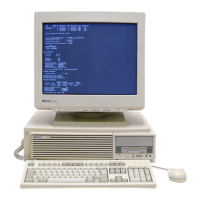2-32 Theory
of
Operation
The SELF
TEST
switch latches to allow continuous self-test. Bit
13
in
R2
is
set while the SELF
TEST
switch
is
latched.
The
service panel
output
module
code
in
the loader ROM reads that bit to
see
if the SELF
TEST
switch
is
latched. If
it
is,
and
no
loadee can
be
found to load, self-test
is
restarted by writing a
24
hex to
Rl
following a few seconds delay for stack cooling.
Non-Maskable Interrupt
This interrupt allows
an
110
card to reset the processor. The software
is
informed of this interrupt by
a poll response
and
bit
14
of
R2
set. An
110
interface clear (IFC)
is
issued to remove the poll
response.
Jumpers
on
the SCM can connect this line to the power supply reset
or
self-test signals.
Service Panel Switches
Three
momentary
switches
on
the service panel cause a poll response
and
bits
in
R2 to
be
set.
The
switches are
RESET
(bit 0),
START
(bit 12),
and
MEM
DUMP
(bit 15). They can
be
cleared by
writing a
10
hex to
Rl.
14.7456 MHz Clock
This clock
is
generated
on
the SCM, buffered,
and
sent to the
110
backplane. It
is
used
by the
110
cards for
baud
rate generation
and
for driving state machines.
Service Panel
The service panel, located behind the
computer
front panel, provides
all
the information necessary
to diagnose hardware failures to the level of a field-replaceable module.
The
control logic for the
service panel
is
on
the SCM
and
consists of a microprocessor
and
supporting circuits.
The service panel has 4 switches
and
27
LEOs. The switches are defined as: RESET, START,
MEM
DUMP,
and
SELF TEST. The LEOs are defined as POWER ON, RUN, SELF TEST,
and
there are several fault-indicating LEOs.
Switches
The following paragraphs define the four switches
on
the service panel.
RESET
Switch
When
this
momentary
pushbutton switch
is
pressed
it
causes the system to reset via a software
interpretation of
an
SCM
board
poll response
and
status message.
All
programs running
in
the
machine
are
stopped
and
the
RUN
LED
is
turned
off.
After reset
is
complete, the system waits for
the
START
or
MEM
DUMP
switch to
be
pressed.
START
Switch
When
the
START
switch
is
pressed, the auto-start procedure
is
initiated. System
powerup
also
initiates auto-start.
The
auto-start procedure automatically loads a selected program which starts
up
the user's application.
If
no
auto-start
file
is
found, the system enters
an
idle state
and
waits for
an
external stimulus. If a
system console
or
operator
interface
is
attached to the computer, the
operator
or
programmer
has
control of the system
and
can bring
up
the system manually.

